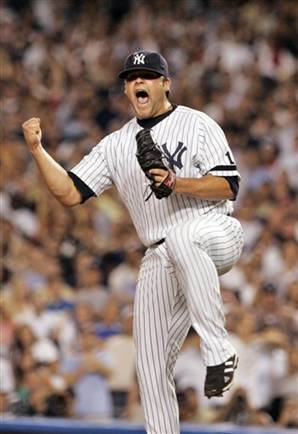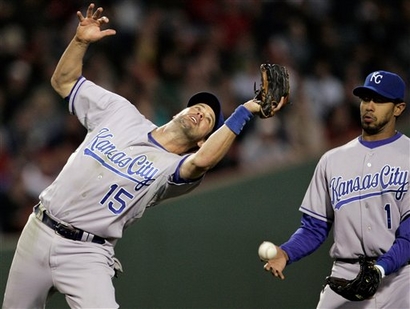With the MLB regular season (almost) over, now, it's finally time to talk about the season's awards. Whatever happens in the White Sox/Tigers make-up game today is not going to have an effect on any of this.
First, the big ones...
American League Most Valuable Player -
Who should win it:
Based on the most comprehensive, unbiased statistical analysis available to us, the best player in the league (who is, by definition, the most valuable) in 2008 has been, unfortunately, Dustin Pedroia, the Red Sox secondbaseman. Besides that, Pedroia leads the league in some of the obvious stuff, too, like Hits, Doubles, and Runs scored, not to mention being second in batting (.326), and third in Singles, Plate appearances, times on base, and at-bats per strikeout.
These stats may seem a bit obscure, but they're one of the reasons that he's likely to win the award: He was always playing, and hardly ever striking out, and therefore most of the voters won't remember times when he came up in a big spot and whiffed to end the game, or something like that. This is of course a silly reason to vote for him, but for once the perception actually matches the reality, so even if the BBWAA vote for him for the wrong reasons, it will be for the right man.
It's worth noting that the best hitter, perhaps even the best player in terms of quality, by a slight margin, has actually been Alex Rodriguez, with a VORP of 65.6, and a WARP of 8.9. Unfortunately, A-Rod missed more than 20 games with an injury, and it's tough to make up for that. The team went jut 9-15 in the games he didn't play, though that wasn't all his fault. Having him around for those three weeks or so might not have made the Yankees a playoff team, but it could have made A-Rod a clear MVP again, with about 10.2 WARP, assuming similar performance.
Following A-Rod on the VORP list are Grady Sizemore at 62.7 and Pedroia at 62.4. Both Pedroia and Sizemore played the whole year and hit very well, but where Sizemore's defense actually robs him of some value (he's -12 Fielding Runs according to Baseball Prospectus), Pedroia's value is added to by his work at the keystone, a +6 FRAA, which makes him a total of 9.8 WARP, or Wins Above Replacement Player (for his position), tops in the Junior Circuit.
It should be noted that Twins catcher Joe Mauer, despite missing about 20 games (which is pretty good for a catcher), finished a very close second, at 9.2 WARP. He should get his fair share of votes too, especially if he gets a key hit in today's one-game playoff or something. I still expect that Pedroia will win it, but I think it will be close.
The X-factor here, perhaps, is that Mauer may lose the MVP race if the Twins' beat writers don't agree on him and instead vote for Morneau (.302/23/129) and all his pretty RBI. The same thing happened to A-Rod in 1996 when he was a teammate of Ken Griffey. Cliff Lee should draw a few votes, too, for leading the league in wins and ERA, even though he had an easier time of it than Roy Halladay.
Close, but no Cigar: Sizemore, Josh Hamilton, Jermaine Dye, Kevin Youkilis, Miguel Cabrera
Felled by their Injuries: Ian Kinsler, Milton Bradley, Carlos Quentin
American League Cy Young Award
With respect to Mike Mussina's first 20-win season and Dice-K's 18-2 record, and K-Rod's 62 Saves, there are really only two serious contenders for the AL Cy Young Award, Cliff Lee and Roy Halladay, and they're probably closer than you think.
Lee leads in ERA by about two-tenths of a point, 2.54 to 2.78, and in adjusted ERA 175 to 155 (with Dice-K in between at 158). Lee also leads in Wins, 22 to 20, and winning percentage, but those numbers have a lot to do with his defense, run support and bullpen help, so Lee shouldn't get as much credit for the Wins and Losses as he actually will. Halladay has a significant lead in innings pitched, 246 to 223, and strikeouts, 206 to 170, meaning that he's done more of his own dirty work, so to speak.
The innings difference doesn't look as sexy as that 22-3 record, but it would be difficult to overstate the effect that absorbing those innings has on the team. I've seen it discussed in terms of looking at the net difference between the two pitchers, i.e. Halladay pitched 22.7 more innings, but he gave up 13 more earned runs, so that's like adding 23 innings of a pitcher with a 5.15 ERA.
But of course, Halladay did not just pitch two and a half additional, sub-mediocre games than Lee did. He made two more starts, and he averaged slightly more innings per start, 7.38 to 7.20, plus he pitched 2.1 shutout innings and got credited with a Hold in his one relief appearance, something for which Lee was never called. Making more starts takes pressure off the rotation, and therefore the manager, to put a #5 guy in there, and his league-leading nine complete games (Lee had 4) took a lot of pressure off the bullpen.
Whether you buy my argument that Halladay has been just as good or better, considering his competition both on the mound and with the bat, is basically irrelevant. Lee is going to win the award going away, with Halladay and perhaps Frankie Rodriguez, Mussina and Dice-K far behind him.
Oh, and in case you're wondering, K-Rod's record of Sticking Around Til the End of 62 Games that Weren't Total Blowouts has already gotten more attention than it deserves, and he'll get more votes than he deserves for it, but he won't win it. We can thank Cliff Lee for that.
Rookie of the Year:
For a while there it looked like Tampa Bay's Evan Longoria would win the thing easily, but he got hurt and missed some time, and in his absence, a few others had a chance to make some noise. Alexei Ramirez of the White Sox set a rookie record by hitting four grand slams this year, and will get some votes, but his lackluster .315 OBP (thanks to walking unintentionally only once every ten games or so) and ineffectiveness on the basepaths (13 for 22 in steals) plus his awful defense at second base (-12 FRAA) should keep him out of serious discussions for the RoY.
Boston's Jacoby Ellsbury led the AL with 50 steals, and led AL rookies with 98 runs scored, but he slowed down after the All Star break, and didn't hit for power or hit for much of anything away from Fenway Park, so he won't get it either.
Kansas City's shortstop Mike Aviles turned some heads by hitting .325 in about two-thirds of a season, but I just don't think he played enough to get serious consideration.
What about pitchers? They can win this award, too, you know.
Detroit's Armando Galaragga won 13 games, pitching 179 innings with an impressive 3.73 ERA that ranks 15th in the AL. (NOTE: His insanely low .239 BABIP likely means that he's in for a rude awakening next year when Lady Luck catches up to him.)
Joba Chamberlain was even more valuable, in terms of VORP, but due to injuries he pitched only 100 innings and will generally be viewed as a disappointment, at least for this season. LAnahfornia's Jose Arredondo went 10-2 with a 1.62 ERA in 61 relief innings, but he probably won't get much support. Glen Perkins of Minnesota went 12-4, but then a decade ago El Duque did that too, with a better ERA, and he finished 4th in the voting.
Oakland's Brad Zeigler started his career with a record 38 consecutive scoreless innings, and ended the season as the A's closer, but nobody ever heard of giving an award to a guy who went 3-0 with 11 saves, even if he did post a Bob-Gibson-esque 1.06 ERA in 59 innings, so that's not gonna happen. Besides, he might not have been the best rookie reliever in his own bullpen, as Joey Devine finished the year with a 0.59 ERA in 45 innings.
So we're back to Longoria, which is where we should be. Not only did he lead all AL rookies in homers, RBI, slugging and OPS, but he led the field in VORP and WARP as well, by a healthy margin, thanks to his excellent defense.
My votes would go for Longoria, Galaragga and Aviles, in that order.
Comeback Player of the Year
I almost forgot it, but the award nobody wants to win has got to be won by somebody. Mike Mussina is an excellent candidate, pitching 200m innings, winning 20 games and finishing 5th in the AL in ERA, a year after posting a 5.15 ERA in 152 innings. Along those lines, Zach Greinke would be a good story, too, given his struggles since his promising rookie campaign five years ago and the 13 wins and 200 innings he posted this year. A.J. Burnett won 18 games after two injury plagued seasons.
There's no shortage of hitters with impressive credentials, either. Milton Bradley, despite a few minor injuries, came back to hit .321 with 22 homers a year after playing in only 61 games. Jason Giambi has 32 homers and 96 RBI a year after hitting just .236 with 14 homers. But the best hitter vying for this honor is probably Aubrey Huff, who, besides sharing my brithday, hit .304/32/108 (also 48 doubles and 96 runs) after bouncing around between three teams in two years and hitting just .280 with 15 homers last year.
But if they don't give this award to CLiff Lee, then there's no point in having it. Lee had previously won 18 games once and 14 games two other times, but he dropped to just 5-8 with a 6.29 ERA last year. If that's not a "comeback", I don't know how you would define it.





















